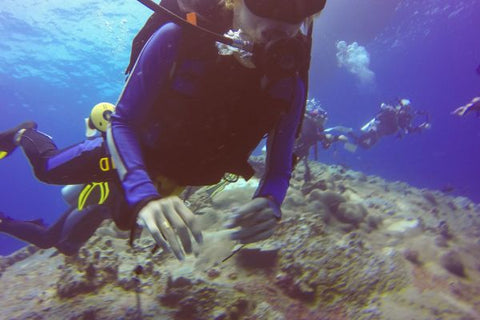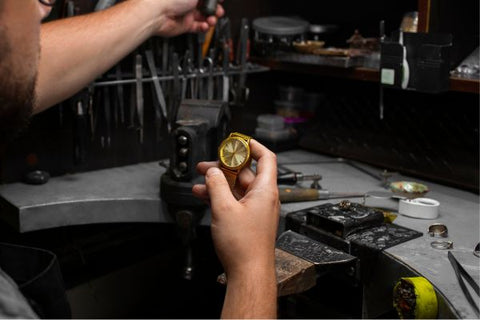Summary :
- What is the water resistance of a watch?
- Waterproofing levels: understanding the standards and markings
- How do you know if a watch is really waterproof?
- Factors that influence everyday waterproofing
- How to maintain the water resistance of a watch?
- The evolution of materials and technological advances
- When and why should you have the waterproofing checked?
The water resistance of a watch is its ability to resist water and humidity without altering its operation. More than a simple technical criterion, it guarantees the longevity of the mechanism and the preservation of the aesthetics of your timepiece. It is an essential issue to fully enjoy its elegance, in all circumstances.
What is the water resistance of a watch?
The water resistance of a watch is defined by its ability to resist the infiltration of water or humidity. It is a set of technical devices – gaskets, crown, pushers, case back – designed and assembled with precision in order to preserve the internal mechanism. The more elaborate this system is, the more the watch can fearlessly face rain, hand washing, or even partial or complete immersion in water.
The importance of water resistance extends beyond just water activities. Even a light rain can cause corrosion of components, degradation of internal oils and malfunctions over time. Internal statistics from some watchmaking workshops indicate that 20 to 30% of repairs involve problems related to humidity. Thus, mastering the basics of water resistance is a real asset, both for an informed collector and for an enthusiast wishing to extend the life of his watch.
Waterproofing levels: understanding the standards and markings

Terms such as “Water Resistant 30M”, “50M” or “100M” should not be interpreted literally. “30M” does not mean that you can dive to a depth of 30 meters. These indications reflect an equivalent resistance to static pressure. For example, a “Water Resistant 30M” watch will withstand splashes of water, rain or hand washing, but not prolonged swimming. For swimming, it is advisable to choose at least “100M”, and for diving, we will turn to models “200M” or more. Iconic timepieces, such as the Rolex Submariner , easily reach 300 meters, offering legendary water resistance that has become a benchmark in terms of robustness and reliability.
The ISO 22810 standard unifies and guarantees these levels. It requires rigorous laboratory tests, checks resistance to temperature changes, the strength of seals and the reliability of components subjected to pressure. Without this type of standard, it would be difficult to know whether a watch is truly waterproof or whether the term "Water Resistant" is just a marketing ploy. According to the Federation of the Swiss Watch Industry (FH), only watches that have passed these tests can officially display their water resistance.
How do you know if a watch is really waterproof?
The mere presence of an inscription on the dial does not guarantee long-term water resistance. A new watch, certified by a standard, may lose its water resistance over time. The seals age, shocks deform the case, temperature variations expand or contract the materials.
To actually check the watertightness, professionals use pressure chambers. The watch is subjected to compressed air, then immersed in water. The appearance of air bubbles signals a potential infiltration.
Such a test usually costs between 30 and 100 euros. It allows you to confirm the condition of your watch and, if necessary, replace the gaskets. High-end models often incorporate elements that increase resistance: screw-down crowns, sealed pushers, hermetic caseback. But even these solutions require proper use: screwing the crown down incorrectly after setting the time can be enough to compromise the water resistance.
Factors that influence everyday waterproofing
The gaskets, often made of rubber or polymer, are sensitive to heat, cold, and chemicals. A rapid change from hot to cold water can cause them to deform. Perfumes, lotions, chlorine, and sea salt gradually attack the material, reducing the watch's ability to resist water.
In addition, every intervention, such as changing the battery or maintaining the movement, represents a risk. When the case is opened, the watertight barrier is broken. The gaskets must then be replaced and the compression checked. This is why most watchmakers recommend testing the watertightness every one to two years.
How to maintain the water resistance of a watch?
After each contact with salt water, rinse your watch with fresh water and dry it carefully. Avoid operating the crown and pushers when it is submerged. Have your timepiece serviced regularly, ideally every 12 to 24 months, in an approved workshop. Such maintenance, billed between 100 and 300 euros depending on the model, ensures the replacement of gaskets, the checking of the mechanism and the maintenance of water resistance.
These actions extend the life of your watch and ensure its proper functioning. Even if the investment may seem significant, it is a valuable asset to maintain the value and aesthetics of your timepiece in the long term.
The evolution of materials and technological advances
Modern watchmaking benefits from new technologies. Corrosion-resistant materials, such as high-end stainless steel, ceramic or composites, make it possible to increase water resistance. Gaskets, now made of more robust polymers, retain their elasticity for longer. Technological advances have made impressive water resistance possible, allowing diving up to 3,000 meters for some models.
These advances are not reserved for very high-end watches. Today, we find affordable pieces, certainly not intended for extreme depths, but offering very good value for money. A luxurious design, good water resistance and quality materials ensure comfort of daily use and exemplary durability.
When and why should you have the waterproofing checked?

It is advisable to have the water resistance checked every one to two years, especially if you regularly expose your watch to water. However, this period is indicative: signs such as fogging, loss of precision or unusual cracking when handling the crown should alert you. An early inspection helps avoid costly repairs and preserve the value of your timepiece. Maintenance guarantees not only mechanical integrity, but also aesthetics.
By understanding the standards, regularly checking its water resistance and maintaining it carefully, you will enjoy your waterproof watch for a long time.


What is the death zone in watchmaking?
What are the characteristics of Japanese watches?